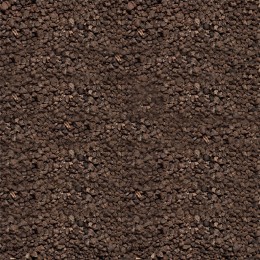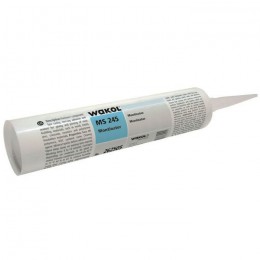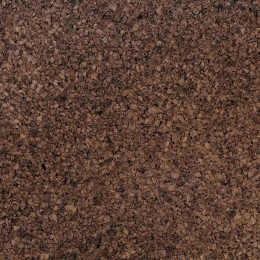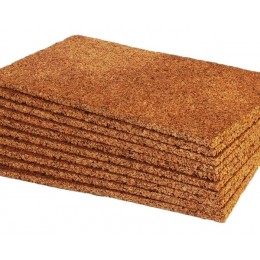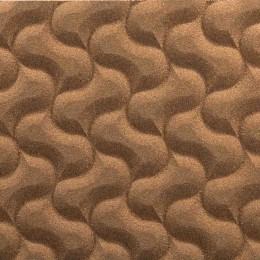Cork insulators
Cork is the bark of the quercus suber tree. Born to be a natural shield that protects the live heart from hot, cold, humidity, flames and external attacks. Nature has given the best of it and thanks to the modern technologies we offer you a wide range of panels, rolls and granulates to insulate and protect your home. Constant and inhaled performances in time, durability, waterproofability, breathability to steam, simultaneous cold, hot and noise insulation, endless possibility of application and sustainability make it the best insulation available in building. Total isolation is only with cork! You don't have a choice!
CHOOSE THE CORK INSULATOR THAT BEST SUITS YOUR NEEDS.
Blond or brown panel, thin or thick, also available in granular form. In the following lines, we will review cork insulators by listing their uses in different situations: in thermal insulation coatings, in the insulation of roofs, walls, and floors.
It is well known that cork insulators are highly appreciated for their thermal and acoustic qualities, which enable them to regulate room temperature and reduce the impact of external noise.
But that's not all: cork insulators are also eco-sustainable and completely natural. Cork is a renewable material obtained from the bark of the cork oak tree, harvested without the need to cut down trees, and with a production process that does not involve the use of chemicals or toxic substances.
Choosing the right cork insulator ensures maximum living comfort and savings on your energy bill.
Scroll the table to the right to view all the applications:
| Cork Applications | External Coatings with Plaster | Exposed External Coatings | Internal Coatings with Plaster | Exposed Internal Coatings | Roof | Attic | Wall Blowing | Subfloors | Under Flooring |
|---|---|---|---|---|---|---|---|---|---|
 |
 |
 |
 |
 |
|||||
 |
 |
||||||||
 |
 |
 |
 |
 |
 |
||||
 |
 |
 |
|||||||
 |
 |
 |
|||||||
 |
 |
 |
|||||||
 |
|||||||||
 |
 |
 |
|||||||
 |
 |
 |
CORK INSULATION PANELS: WHICH PANELS TO USE?
External Thermal Insulation
It is important to distinguish between internal insulation and external insulation. While internal insulation offers a wide range of solutions, external insulation has historically relied on the use of expanded brown cork, self-bonded.
There are several reasons why brown cork is preferred for external applications:
1 - It is available in thick panels that meet current thermal insulation standards.
2 - It is a geometrically stable material, durable over time, with an unlimited lifespan.
3 - For the same thickness, it offers the highest insulating power among cork panels.
.jpg) In most cases, brown cork panels used externally are protected with a natural hydraulic lime coating. If the final plaster or paint is also natural and breathable, the entire layering of the cork insulation guarantees wall breathability.
In most cases, brown cork panels used externally are protected with a natural hydraulic lime coating. If the final plaster or paint is also natural and breathable, the entire layering of the cork insulation guarantees wall breathability.
There is also the option of a cork "visible surface" finish. By choosing the BioPan Rev panel, it is possible to complete the application with a brown cork panel specifically manufactured with techniques that make it resistant to rain and weather.
 The BioPan Rev panel finish offers a sleek, dark-toned aesthetic that is particularly suited to modern building designs where clean lines and design are key.
The BioPan Rev panel finish offers a sleek, dark-toned aesthetic that is particularly suited to modern building designs where clean lines and design are key.
When the overall thickness is significant, an initial layer of BioPan can be formed, followed by a visible layer of BioPan Rev.
Internal Thermal Insulation
Blonde cork panels can also be used for external insulation. However, they are generally better suited for internal insulation, roof insulation, cavities, or underflooring.
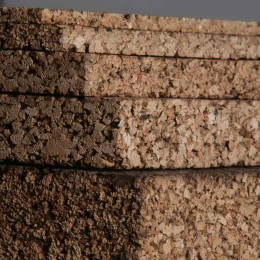
The choice to use blonde cork panels is often driven by their affordability, higher density (greater compression resistance), and availability in very thin panels, making them highly versatile and aesthetically pleasing.
In many older homes, insufficient thermal insulation leads to difficulties in heating (and cooling) spaces and often results in condensation and mold on walls. The wide range of cork products offers solutions ranging from thin coverings that resolve corner mold issues to full internal insulation with thick panels.
Anti-Condensation and Anti-Mold Insulation
Condensation on walls and the resulting mold is mainly due to inadequate wall thermal insulation. Poorly insulated walls are too cold inside, causing indoor humidity to condense on the cold surface as water.
Applying a cork layer makes the wall "warmer," preventing humidity in the air from condensing and keeping the wall dry, thus avoiding mold formation.
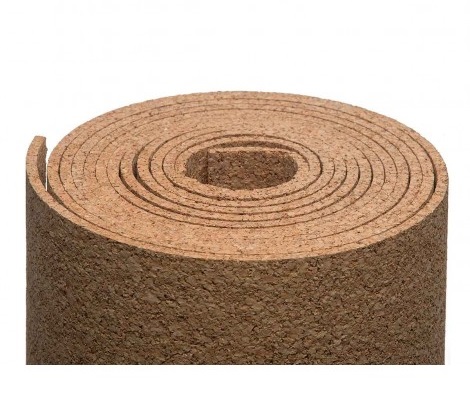
Thin sheets of supercompressed cork are used for thermal anti-condensation insulation, even as thin as 2-3 mm, suitable for mild mold issues. These cork sheets can be left visible or coated with lime-based plaster.
Supercompressed cork for this type of insulation ranges from 2 mm to 10 mm thick. Thicker panels provide better thermal insulation, enhancing comfort and energy savings.
Internal Insulation with Blonde Cork Panels
Cork insulation panels are often ideal for internal walls, providing excellent thermal and acoustic resistance. Cork retains heat inside rooms during winter, ensuring effective insulation and reducing energy costs. In summer, cork prevents heat ingress, keeping rooms cool.
Blonde cork panels, ranging from 2 cm to 10 cm thick, are used to create internal insulation that significantly reduces thermal dispersion, enhancing comfort and energy savings.
For example, a 3 cm panel doubles the insulating capacity of an uninsulated wall. Cork also offers excellent acoustic insulation alongside thermal benefits.
As with brown cork insulation, it is recommended to use natural hydraulic lime adhesive for blonde cork panels, ensuring breathability and healthy indoor air quality.
INSULATING WALL CAVITIES WITH GRANULAR CORK?
THE BEST CHOICE!
Granular cork, made from cork processing residues, can be used to fill wall cavities. Thanks to its thermal properties, granular cork helps maintain consistent indoor temperatures, reducing energy costs.
Insulating wall cavities with granular cork is an effective, simple, and economical solution for buildings with perimeter wall cavities.
In modern construction, wall cavities are usually filled with adequate insulation to meet thermal standards. However, older construction often leaves cavities empty or partially filled.
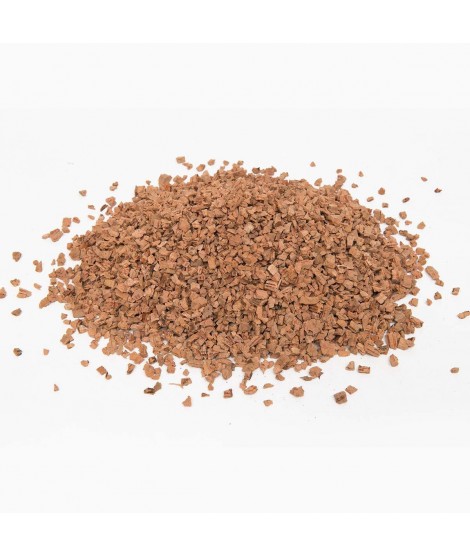

Cavity insulation can be done from inside or outside the building, depending on cavity capacity. This method complements internal or external insulation, reducing overall insulation thickness and maximizing space, especially indoors.
Granular cork insulation is also quick and non-invasive, requiring no removal of wall or ceiling finishes, ensuring minimal disruption to occupants.
HOW TO INSULATE THE ROOF (OR ATTIC) WITH CORK?
Cork is an ecological and sustainable material that is perfectly suited for roof insulation or attic insulation. Thanks to its thermal and acoustic properties, cork can provide excellent living comfort, protect against cold and heat, and reduce energy consumption.
To insulate the roof (or attic) with cork, there are several methods.
1 - The most appropriate method is used in new constructions and involves forming the insulating layer immediately under the tiles for sloped roofs or in the attic when it is not designed to be habitable. In both cases, brown or blonde cork panels can be used: brown cork has greater insulating power for the same thickness, but blonde cork is generally more economical.
2 - If instead you need to insulate an existing roof, it is still possible to use brown or blonde cork panels. These panels can be placed between the wooden beams of the roof or applied to the sloped surfaces of pitched roofs. In this case, the process is the same as for external wall insulation: applying the panels with natural hydraulic lime adhesive/render, securing them with dowels, and finishing with a final layer of lime-based render reinforced with mesh.
3 - When thermal insulation is needed for the floor of an uninhabitable attic, the most convenient method is to use granular cork. This can be leveled dry in non-walkable attics or mixed with a binder or hydraulic lime if a lightweight insulating screed suitable for finishing with a walkable floor is required.
INSULATING SUBFLOORS AND FLOORS WITH CORK.
In subfloor insulation, cork panels or granular cork can be used. The situations vary: simpler in new constructions and much more complex during renovations, where space constraints often make proper thermal insulation challenging.
In a new construction, thermal insulation is placed in the subfloor, preferably below the space dedicated to utilities. In this case, the insulating layer can be made with two or three layers of blonde or brown cork, on which a protective screed is poured to serve as the base for utility installations.
Renovation projects often involve utilizing every available space, even the smallest:
Replacing utility systems
A common renovation intervention is the replacement of electrical and plumbing systems. After dismantling the old subfloor and updating the utilities, it is advisable to restore the filler screed with an insulating material. Granular cork is the most suitable insulator for creating a "lightweight screed" for effective thermal and acoustic insulation of floors.
If the available space permits, a layer of cork mixed with lime/cement or binder can be poured first, followed by a more solid screed suitable for flooring. If space is limited, a single partially lightweight screed with a percentage of granular cork can be made, providing an insulating subfloor while still being suitable for flooring.
Floor insulation without dismantling the subfloor
When room height allows and you want to improve the thermal and acoustic insulation of the floor, it can be done by laying a layer of blonde or brown cork panels of adequate thickness before installing the new flooring.
Replacing old flooring with cork flooring.
If you want to renew the flooring without incurring additional expenses or modifications (e.g., cutting or raising interior doors), our catalog offers a wide range of cork flooring starting from just 3mm, improving thermal and acoustic insulation while giving your home a fresh look.
When opting for a floating floor
A very common intervention is the installation of a thin floating floor over the old flooring to be renovated. In such cases, it is highly recommended to place a layer of cork, available in rolls from 2 to 10mm thick, underneath. This cork layer will both improve the thermal insulation of the floor and effectively reduce footstep noise.


























































